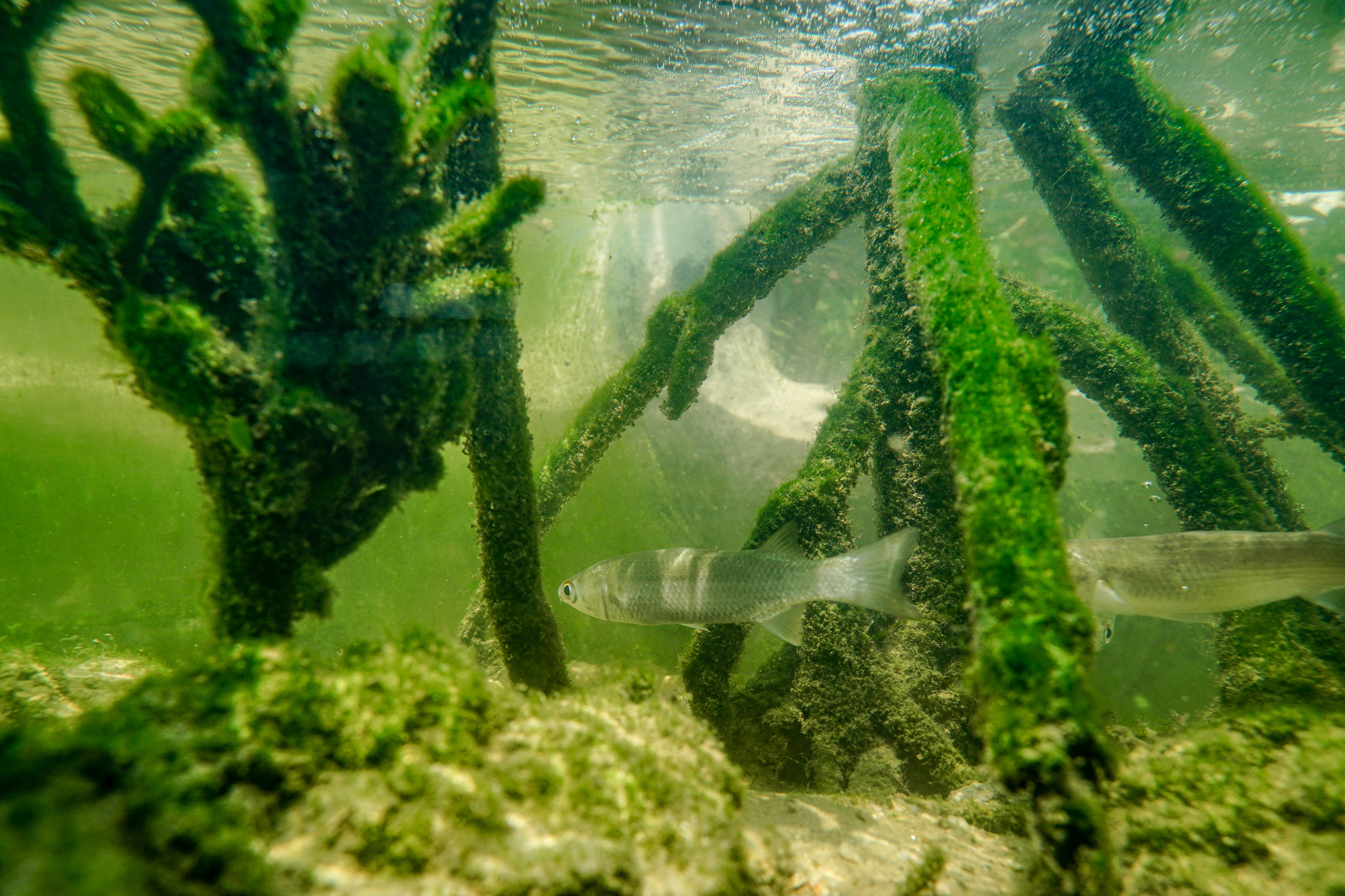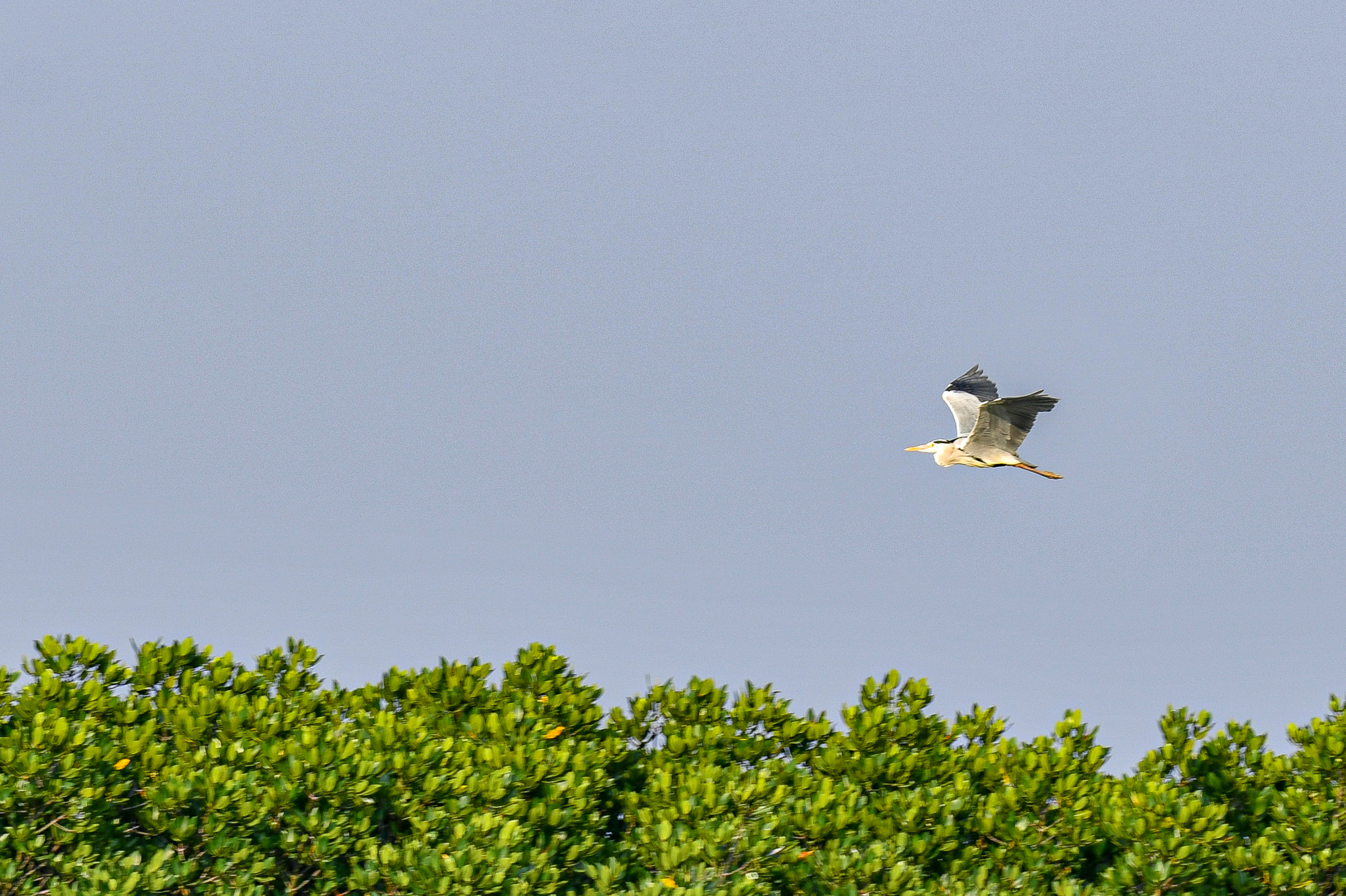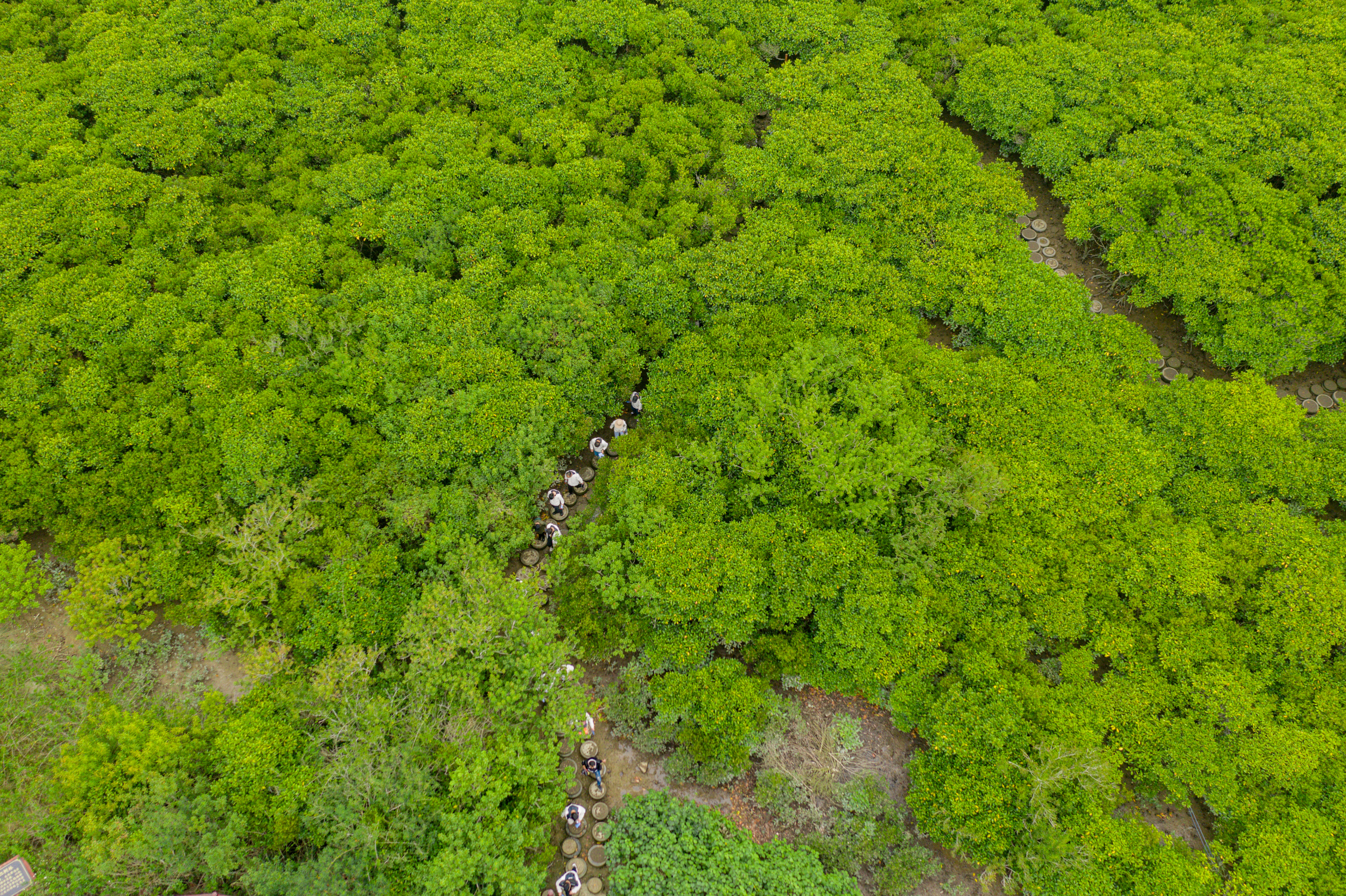Further reading|The "Green Value" of Zhanjiang Mangrove Forest
In April, take a boat shuttle between the island weirs, the blue sea and blue sky, and the green trees and forests are in front of you. In the sky, herons fly by from time to time, and there are flocks of shrimp and crabs in the shallow sea of tidal flats, accompanied by the "song" of the waves, making this land full of life.
This is the Jinniu Island mangrove forest area in Zhanjiang City, Guangdong Province, with more than 100 hectares of "national treasure" mangrove forests. "They grow on the impact tidal flats at the junction of land and sea, and have multiple functions such as water purification, berm and beach fixation, wave prevention and disaster relief, biodiversity maintenance, carbon sequestration and carbon storage, etc., which is a rare resource for Zhanjiang, which has the longest coastline in Guangdong Province. Following the explanation of the staff of the Guangdong Zhanjiang Mangrove National Nature Reserve Administration, the reporter walked into the "green world" of mangroves.

Mangrove area of Jinniu Island, Zhanjiang City, Guangdong Province. Photo courtesy of the interviewee
Plant-Breeding Coupling: Balancing Development and Conservation
Zhanjiang's understanding of mangroves has undergone a deepening process.
Zhanjiang, which relies on the sea to eat the sea, has a breeding tide at the end of the last century. Along the coast of Jinniu Island, villagers have carried out pond farming, but due to the lack of corresponding systematic theoretical research and technical guidance, the degradation trend of red groves in the pond is obvious.
"Long-term aquaculture has damaged the growth environment of mangroves, and the direct removal of breeding ponds will bring economic losses to farmers. In the face of development problems, Zhanjiang City began to carry out the research and development of mangrove planting and breeding coupling system model and ecological demonstration exploration in this area, so as to balance the contradiction between ecological protection and economic development. Lin Guangxuan, Guangdong Zhanjiang Mangrove National Nature Reserve Administration, said.

Explore the implementation of planting and breeding coupling in the reserve. Photo courtesy of the interviewee
Following the law of material cycle and energy flow in mangrove ecosystem, combined with the principle of symbiosis and complementarity of species, the needs of stakeholders, environmental capacity, conflict resolution mechanism, mangrove protection and restoration and other factors were comprehensively considered. Zhanjiang City planted mangrove forests in higher places such as Yilin Tangji and Duidao, and cultivated aquatic products in lower places such as aquaculture ponds and tidal ditches, and explored and formed a coupling coexistence model of mangrove planting and ecological aquaculture, which provided experimental data and planting experience for mangrove planting research in other areas of Zhanjiang.
"As Zhanjiang continues to reforestation and restoration, our mangrove conservation strategy has also changed. Our previous focus was on reducing the impact of human factors on mangroves, with the hope of protecting mangroves by controlling the flow of people into mangrove areas. Lin Guangxuan told reporters, "Now it is more about opening the door, so that more people can come in, understand the importance of protecting mangroves, and call on everyone to participate in the action of protecting mangroves." ”
Protecting mangrove forests is not just Zhanjiang in Guangdong. By the end of 2023, Guangdong Province had completed the creation of 2,509 hectares of mangrove forests and restored 2,476 hectares of existing mangrove forests.
At the same time, Guangdong Province has also promoted the establishment of a provincial-level "index pool" for mangrove afforestation incentives, and explored ways to open up the achievements of ecological restoration to feed back the construction and development of prefectures and cities. In 2023, Guangdong Province officially issued the "Notice on Carrying out Rewards and Punishments for the Ecological Restoration of Mangroves and Historical Mines", which stipulates that on the basis of the national reward of 0.4 mu of construction land for planting 1 mu of mangrove forest, 0.1 mu of new annual construction land incentive index will be awarded, and in the annual land use plan, in accordance with the annual task of mangrove planting, the new construction land plan index will be reserved to form an "index pool", which can be cashed in advance after completing the task, mobilizing the enthusiasm of local protection and restoration of mangroves.
Ecological conservation: to achieve harmonious symbiosis
The mangrove forests have grown, and the aquatic life has increased, attracting more wild birds to inhabit and feed. They are not only ecological inspectors, but also the number and variety of birds in Zhanjiang are also important data for mangrove scientific research. "Every year, we do a bird survey in the reserve to record how many birds come to Zhanjiang for the winter, so that we can adjust the conservation strategy of the mangrove forests in the reserve. Zhang Wei, director of the Guangdong Zhanjiang Mangrove National Nature Reserve Administration, said. She also told reporters that with the increase in the number of migratory birds, a part of the mangrove forest will be cleared in the reserve, leaving the tidal flats exposed, leaving more space for migratory birds to perch and feed.
Regarding the changes of wild birds in Zhanjiang, Cheng Li of Zhanjiang Bird Lovers Association has a deep experience: "In recent years, more and more birds can be photographed in the mangrove forests of Zhanjiang. As a national first-class protected animal, the black-faced spoonbill used to be difficult to see in Zhanjiang, but now, it can be seen more and more. ”

Herons skim the mangrove forest. Photo courtesy of the interviewee
As the conservation of mangroves continues to advance, there are more and more birds in the reserve, and the biodiversity of the wetlands is also enriched. According to the statistics of the Guangdong Zhanjiang Mangrove National Nature Reserve Administration, there are 26 species of true mangrove and semi-mangrove plants, 312 species of birds, 544 species of macrobenthic animals, 300 species of insects and 134 species of fish.
In the reserve, the mangrove forest has changed, as well as the livelihood and lifestyle of the villagers. Walking in the science popularization corridor of the mangrove reserve, the QR code signs of mangrove wetland plant science popularization attracted the attention of reporters. Turn on your mobile phone, scan the QR code, and a short science video window will immediately pop up: "The seeds of mangrove plants will grow on the mother tree, germinate the hypocotyls, and will only break away from the mother tree after maturity and fall into the sludge to 'settle down'. ”
In 2023, the reserve will invest a total of 8 million yuan in the project to scientifically design, comprehensively transform and improve the ecological service level of Jinniu Island, and build a green and beautiful Guangdong ecological demonstration site and science popularization and education site on Jinniu Island, which has also benefited many local villagers. Zhang Wei told reporters: "We took the initiative to communicate with the villagers, providing patrols, forest rangers, security, cleaning, management and other jobs in the reserve, and many villagers also opened farmhouses around the reserve, selling local specialty food. ”
Nowadays, the Jinniu Island area has taken on a new look, becoming a beautiful business card of Zhanjiang City's eco-tourism, and also becoming the main front for foreign exchanges and publicity and education. According to statistics, in 2023, more than 50 nature education activities will be carried out in the Jinniu Island area of Zhanjiang, with a total of more than 100,000 visitors. "The traditional culture of Zhanjiang mangrove area is rich and colorful, and the next step is to combine mangrove science education with local folk customs to provide tourists with a unique cultural experience. Zhang Wei said.
Carbon sequestration and gold generation: Exploring the transformation of ecological value
The use of ocean activities and marine organisms to absorb carbon dioxide from the atmosphere and fix it in the ocean is called "blue carbon". Among them, mangroves, as one of the three major blue carbon ecosystems, have a much higher carbon sequestration capacity than terrestrial ecosystems, and their carbon sequestration potential can reach 3-5 times that of tropical terrestrial forests, and the global mangrove area accounts for only 0.1% of the world's total land area, but the carbon sequestration can reach 5% of the world's total carbon sequestration.

Mangrove area of Jinniu Island, Zhanjiang City, Guangdong Province. Photo courtesy of the interviewee
Zhang Wei told reporters that this is because mangroves have two "mysteries": on the one hand, mangroves grow fast and can absorb a large amount of carbon dioxide in a short period of time and convert this carbon into biomass, and the underground roots are in an anaerobic environment for a long time, which helps to slow down the decomposition of roots and litter, thereby accelerating the burial of carbon into the ground. On the other hand, mangroves are mostly distributed in sedimentary coastal estuaries, and a large amount of exogenous carbon is brought by the combined action of upstream rivers and ocean tides, which can be quickly fixed in the tidal flats where mangroves grow.
Such a huge carbon storage capacity and potential provides a new idea for Zhanjiang to explore the transformation of mangrove ecological value. "Zhanjiang is the largest and most concentrated mangrove national nature reserve in China, and we also wanted to explore how much carbon these mangroves can offset and how much value they can generate. Zhang Wei said.
To put it simply, the carbon sink trading of mangroves is to allow carbon emitting units to buy the carbon stored in mangroves, so as to achieve "carbon neutrality". Starting in 2019, Zhanjiang City developed carbon sinks from 380 hectares of mangrove forests planted within the protected area between 2015 and 2019 in accordance with certified carbon standards. In March 2021, the "Zhanjiang Mangrove Afforestation Project" carried out by the Administration of Zhanjiang Mangrove National Nature Reserve in Guangdong Province passed the review and was successfully registered by Verra, a VCS development and management organization, and the Beijing Entrepreneur Environmental Protection Foundation purchased the first certified carbon dioxide emission reduction of 5,880 tons of the project at a price of 66 yuan/ton, which was used to offset the carbon emissions generated by the foundation's activities, and reached the transaction of China's first blue carbon project.
"The proceeds from 'selling carbon' will be used for the management and protection of mangrove restoration plots and community participation, so as to continuously maintain the effect of mangrove ecological restoration and form a long-term and stable virtuous circle. Zhang Wei said.
From the idea to the reality, the blue carbon carbon sink trading also provides experience and technical support for the expansion and development of the national carbon market. On October 24, 2023, the General Office of the Ministry of Ecology and Environment (MEE) issued the Methodology for Voluntary Greenhouse Gas Emission Reduction Projects - Mangrove Planting, which provides scientific and standardized guidance for the development of mangrove carbon sink projects. Zhang Jing of the Beijing Entrepreneur Environmental Protection Foundation, who co-authored the compilation, told reporters: "The mangrove construction methodology will promote the implementation of mangrove ecological restoration more scientifically, and at the same time, it will also allow more stakeholders and the public to pay attention to mangroves, dig deeper into the ecological and economic benefits of mangrove ecosystems, provide more diverse and lasting funding sources for mangrove protection, and promote mangrove protection more comprehensively." ”
From focusing on protection to balanced development, from science popularization and education to harmonious coexistence, from practical exploration to blue carbon economy. Zhanjiang is striving to promote the green development of Zhanjiang from the perspective of mangrove protection.







